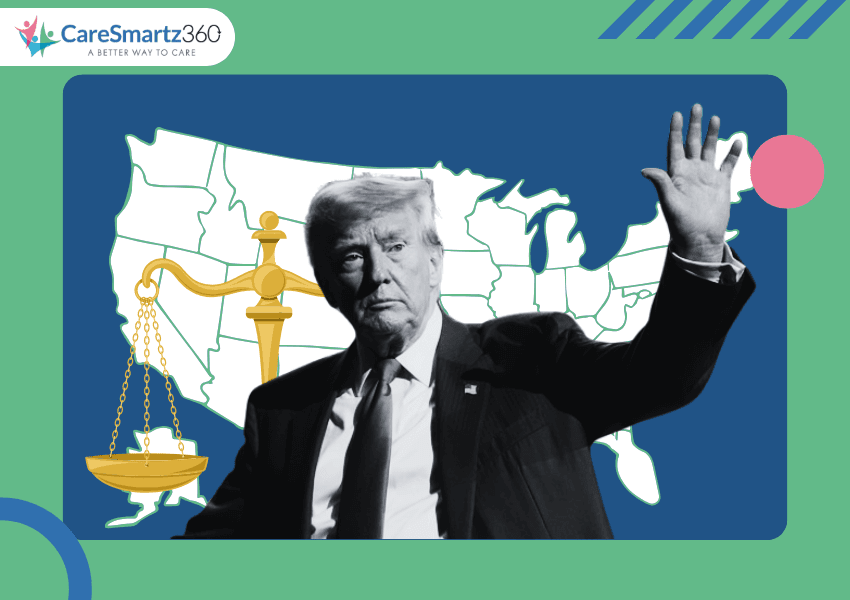
Image Source: Politico
Get ready for a rollercoaster ride because the home care sector is about to experience some significant changes under President Trump’s second term! It’s a high-stakes game, and the pieces are definitely moving.
The team at CareSmartz360 is your guide through the wild world of home care, and here, we bring home all the speculation regarding what happens next under President Trump’s term?
He is back, and he’s not wasting any time shaking things up, or, as he calls it, “Make America Great Again”. Forget what you thought you knew, because we’re about to unpack how his administration could dramatically reshape how we care for our loved ones at home.
Jeanne McGlynn Delgado, American Seniors Housing Association (ASHA) vice president of government affairs, said the Trump administration and Congress can do two things simultaneously: strengthen the border and create opportunities for US employers, specifically those reliant on essential positions, to access foreign workers legally.
Senior living organizations are already evaluating the impacts of Trump’s executive actions to undo Biden-era rules and regulations. Specifically, immigration policies that may affect the industry’s workforce are under review.
There’s also the potential undoing of the home- and community-based requirement for worker compensation.
ASHA has joined a coalition urging the Trump administration to prioritize legal immigration reform, arguing that creating legal pathways for essential workers is key to addressing workforce shortages and boosting economic growth.
A big focus of the new administration is cutting costs, which could put home-based care in the spotlight because of its potential to reduce the total cost of care.
There could be an increase in opportunities for caring for vulnerable individuals, as it’s not just about cutting services, but about being smarter on how they are deployed. However, advocacy will be crucial.
As Dr. Steven Landers, CEO of the National Alliance for Care at Home, mentioned, the industry is concerned about how the U.S. Department of Health and Human Services (HHS) and the Centers for Medicare & Medicaid Services (CMS) implement the laws that are already passed.
Another area to watch is Medicare Advantage (MA).
The big question is whether the new administration will push for expanding MA’s management of Medicare dollars, including a wholesale carve-in of the hospice benefit.
Most people expect to see a continued expansion of MA enrollment and that this expansion will put more pressure to get rid of the carve-out. This could have huge implications for home care providers.
ASHA is also positioning senior living as a cost-effective option for long-term care, compared to nursing homes and full-time home care. When a community participates in the Medicaid waiver program, it offers residents quality options for residential care at a lower cost to the government than other institutional settings. Assisted living communities should be encouraged in these programs.
Senior living providers are hopeful that the Trump administration will eliminate the 80/20 provision of the Medicaid Access Rule, which requires that providers spend at least 80% of Medicaid payments for personal care, homemaker, and home health aide services on compensation for direct care workers.
Industry experts argue that it will be better if the focus is on the quality of care rather than compliance to the 80/20 rule. Also, keep an eye on potential changes to the Occupational Safety and Health Administration (OSHA) healthcare worker safety rule.
It’s not just about new policies, it’s also about how existing ones are implemented. Landers also mentioned the need to fix flaws in initiatives like the hospice Special Focus Program and the Patient-Driven Groupings Model for home health.
It appears that advocacy by and for home-based care providers will be crucial moving forward.
So, there you have it, folks. A second Trump term could mean big changes for home-based care. There’s a lot to watch and a lot to advocate for. It’s going to be an interesting ride, so stay tuned for more updates as they develop!
From immigration reform to Medicare Advantage and Medicaid policies, the industry stands at a crossroads. Will home care emerge as a cost-saving hero, or will regulatory shifts create new roadblocks?
One thing’s for sure: advocacy will be key. As policymakers weigh their next moves, home care providers must step up, voice concerns, and push for smart, sustainable reforms. The stakes are high, and the game is on.
Our users reported 95% customer satisfaction in 2024. Schedule a personal walkthrough to see CareSmartz360, home care software in action.